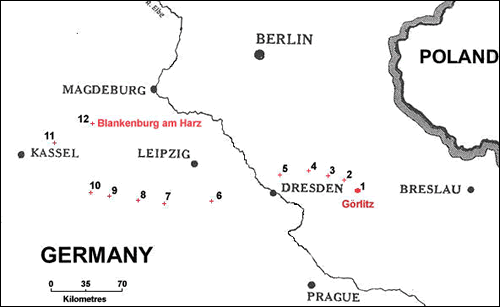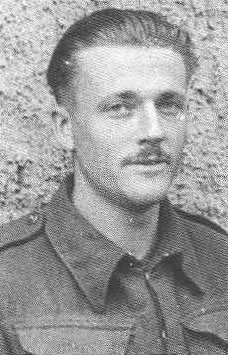In early March 1945 George Trundle was forced to march for 24 days from Görlitz to Blankenburg am Harz where he was eventually liberated. On this page you can hear him describe the march and use a map to follow his progress.
George Trundle enlisted in 2NZEF in 1940 and embarked on the Empress of Britain from Wellington with the Second Echelon in May that year. After a period in England, to which the echelon was diverted, he arrived in Egypt in early 1941. His first action took place in Greece to which he had proceeded with his unit, 21 Battalion, in March 1941. Following the retreat, he missed being evacuated by the navy; instead, he made his way back to Egypt through the Greek islands. He became a POW after being captured by Italian troops in Libya in November 1941.
Read transcript of George Trundle discussing his experiences.
Transcript
It started fairly abruptly—the Russians were breaking through, once again from — and getting fairly close and getting very close and the next time we were on the road...so before we knew it, we had orders to get our gear together and get out. The next time we were on the road. I've got a map [interruption while map is obtained] ... Now — The march out from Gorlitz, VIIIA, covered from Gorlitz to Blankenberg am Harz which is near the town of Gottingen, where Gottingen university is. The towns covered in order were: Gorlitz to Bautzen to Kamenz to Koningsbruck, Meissen where they made the ceramics. We slept in the Meissen works which was lovely and warm, and Borna, Gotha Eisenberg, Stenditz, we spent the night in a stone quarry in the freezing rain, Jena, Schonstet, Halberstalt, Erfurt, Erfurt was where they made the ovens for the Jewish holocaust Duderstadt, Gottingen, Blankenburg am Harz, the Harz mountains were there. That covered 24 days — 3 and a half weeks...
We did that march out and we also saw the column of Jews from our march at one period, which I'll describe...No, we weren't [able to talk to them] Had we been able to we'd have been shot. Our guards, when we saw the Jews to the north, our guys started to look over—they were very curious as to what was going on and our guards were terrifically nervous and even menacing. They knew they'd be in trouble if we were allowed to contact the Jew column. The column was very long and it stretched right back to the horizon behind us. The figures were just pyjama-dressed Jews in their striped, thin uniforms. They carried nothing. Each person had nothing to carry, but in front of this huge column was a small cart drawn by six people laden presumably with their belongings, whatever their belongings could have been. As night fell we lost contact with them and never saw them again....
[Conditions on march]. Usually at night they'd find a farmer's big barn or something like that where we could stay the night but the reason we had to sleep in the stone quarry was that a column had gone through before us and rifled all the farmer's spuds or apples or something and the mayor of the town said let them sleep in the bloody stone quarry so that we spent the night there. It was dreadful— all these horrible rocks and rubbish and pouring freezing cold rain so... We did get issued with — I think— a loaf —this little bun, loaf and a few stews at night when we stopped at night on a farm, soup. Actually any food we saw on the way — fruit or vegetables or stuff — we pounced on and ate.
Map of his march across Germany

This map is derived from the oral history interview with George Trundle. It shows the course of his march with numbers indicating places he mentions in the interview.
Key
- Görlitz - start, Stalag 8A
- Bautzen
- Kamenz
- Köningsbruck
- Meissen
- Borna
- Eisenberg
- Jena
- Erfurt
- Gotha
- Duderstadt
- Blankenburg am Har

George Trundle.
South African killed in brick kiln during march, Arthur Cowan
Arthur Cowan describes a South African POW being shot for disobeying the orders of their guards during his forced march.
The promise had gone out that we would go to a rest situation and ...some days after that we did get to the rest situation and it was in a brick kiln, four storeys, huge and.. the storeys of course were for drying bricks so they were slatted ...with narrow stairways going up to the different stories and ...a most dreadful place...It wasn't helped at all by a report of a couple of corpses lying...ready to be taken out, close to the entrance door. So obviously there had been troops ahead of us and a couple had died there. That didn't help at all. So anyway we got ourselves established. I think we were on the second floor, if I remember, and made a little cubby-hole and shifted a few bricks and found a place to lie which wasn't too bad, same as everyone else was doing. The orders were that no-one, no fires were to be lit whatever. We were already very hungry, of course, as we had been regularly all the way - pretty well - and of course the order not to light fires was impossible to maintain but you had to watch because guards would come through. And so we, along with others, boiled up what stuff we had, which was probably mangolds [type of beet vegetable]. And during the early part of that time the guards had come up and the South African group directly behind us had made themselves a little place ...and the guards came up and they hadn't been careful enough to watch and one of them brewing up was shot dead. Illustrating the fact that the shooting was just - just across the way from - oh - almost immediately behind us, one or two bricks away. Our condition was easily assessed because we never moved from our sleeping position.

Community contributions